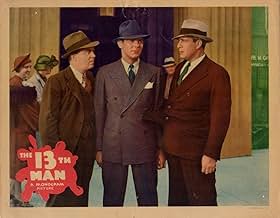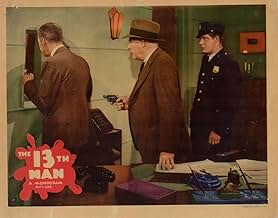A tough district attorney has been cleaning up the town, and has already imprisoned twelve dangerous criminals. As he is about to name the target for his next investigation, he is murdered i... Read allA tough district attorney has been cleaning up the town, and has already imprisoned twelve dangerous criminals. As he is about to name the target for his next investigation, he is murdered in the midst of a crowd. The police have many suspects and hardly any clues, so two reporte... Read allA tough district attorney has been cleaning up the town, and has already imprisoned twelve dangerous criminals. As he is about to name the target for his next investigation, he is murdered in the midst of a crowd. The police have many suspects and hardly any clues, so two reporters decide to investigate for themselves.
- Tony
- (uncredited)
- District Attorney's Aide
- (uncredited)
- Club Patron
- (uncredited)
- KGT Radio Announcer
- (uncredited)
- Dr. Randolph Gorman
- (uncredited)
Featured reviews
The story begins in a town where the District Attorney is running for re-election. In order to gain publicity and rid the town of crooks, he's leading a crackdown. So far, he's arrested a dozen mobsters and on the radio he announces he's about to arrest a 13th. And, as you'd always expect in such a film, the DA is about to assume room temperature before he can divulge who this man or woman is!!
Overall, this is very typical of a B mystery....not just in the ways mentioned above but in its fast pace, run time of about an hour and because it's predictable but still entertaining. Worth seeing if you enjoy the genre or just want to see what the first Monogram release was.
There are a lot of choices, and when the DA falls over dead due to a poison dart, an investigation begins as soon as it's revealed he did not die of a heart attack.
Among the most interested is Swifty Taylor (Weldon Heyburn), a radio journalist. He wants a scoop, so he does some investigating on his own. When his friend (Milburn Stone) runs into trouble, Swifty becomes more determined than ever to solve the case.
Fast-moving B movie.
The story starts when a tough D.A., who has recently put away 12 of the town's most notorious criminals, announces that he will soon target his 13th man. Before he can do so, he is murdered, and two reporters (Heyburn and Milburn Stone, later of "Gunsmoke") decide to investigate, although there are many possible suspects and few clues. While the production itself is strictly low-budget, the murder mystery plot is not bad, without any big holes, and it keeps you guessing to the end.
Overall, while nothing spectacular, this is probably better than average for a B-Mystery.
It's simply a feast for every fan of the reporter movie genre: it gives detailed insight into radio and newspaper work as it was in the 1930s (not that it's TOTALLY changed now: being a journalist will ALWAYS be more or less the same - I'm speaking from experience...), it conveys to you the fascinating atmosphere of the broadcasting studio and the editors' office room; and most of all, it describes the reporter instinct, that driving force that leaves everything else second: when a reporter on a hot trail invites a girl out to an expensive dinner, chances are that the rendezvous will finally end up at a hamburger stand... So the movie tells you clearly what to expect if you fall in love with a reporter - man or woman, no matter; in fact, the protagonist himself explains how things are: "Of course you don't have to be crazy to be a newspaper man, but it does help..."
In the meantime, the film also has a unique way of going through literally ALL kinds of emotions: true love, dark tragedy, romance taken lightly until the real feelings break through - and then again covered up by sudden, unexpected jokes; like when the reporter's secretary who's secretly in love with him starts being REALLY alarmed by the many death threats he gets and begs him to lay off the case, grasping him by his jacket: "Oh Swifty, if anything would happen to you, I'd... I'd..." - "You'd what?", he only asks - and there she lets go of his jacket, turns away, shrugs her shoulders and just replies: "Well, I'd lose my job!" And he adds, equally unmoved: "Well, so would I!" ...
All in all, the movie is a REAL little gem that shows that a simple, cheap 'little' Monogram movie can be just equally moving and suspenseful as an expensive all-star film from one of the big studios; it's a first-class 'whodunit' that leaves us all puzzled until the end - we may have kind of an uneasy feeling from the beginning about who did it, but it just seems too fantastic, too cruel - so we'll have to wait until that dramatic midnight radio broadcast climax where our reporter hero will announce who the murderer is... Don't miss this one, and don't think it's just another 'assembly line product' - it's REALLY different from most of the rest of them!
After two years of dealing with Herbert Yates at Republic, Trem Carr and Ray Johnson left to reform Republic Pictures. They produced a score of movies in their first year, and this was the first released. It's fast, it's moves right along, it's a fair enough mystery, but despite lead Heyburn looking adequate, director William Nigh seems to be more interested in getting his picture in the can and under budget, which is probably why DP Paul Ivano shoots almost all his set-ups in medium two-shots and doesn't move the camera much. There's a lot of editing for Russell F. Schoengarth to do, and he does it very well, keeping this to a non-boring 78 minutes.
Did you know
- TriviaThe first picture released by the reformed Monogram Pictures Corporation, which was temporarily shelved from 1935-37 when its two owners, Trem Carr and W. Ray Johnston, joined with Mascot Pictures' Nat Levine and another independent studio, Liberty Pictures, to form Republic Pictures with Herbert J. Yates (owner of Consolidated Film Industries, a film processing laboratory) at the old Mack Sennett studio. The partnership held for a year until Carr and Johnston, chafing under the autocratic rule of Yates, left the company in 1937 and reformed Monogram. This is the first of a remarkable 20 features the studio would release that year. Monogram would always remain a low-budget outfit, its product geared for rural audiences and second-run theaters. In 1952 it changed its name to Allied Artists, hoping to erase the low-budget "stigma" associated with Monogram.
Details
- Release date
- Country of origin
- Language
- Also known as
- The Thirteenth Man
- Production company
- See more company credits at IMDbPro
- Runtime1 hour 10 minutes
- Color
- Aspect ratio
- 1.37 : 1
Contribute to this page




































